Abstract
The mode of binding of the competitive inhibitor 2-benzyl-3-formylpropanoic acid to the active site of carboxypeptidase A has been studied by x-ray diffraction methods to a resolution of 1.7 A. The actual species bound to the enzyme was determined to be the gem-diol resulting from covalent hydration at the aldehyde carbonyl. Details relating to the process of association of inhibitor with enzyme are unknown at this time: the free aldehyde could initially bind to the enzyme and subsequently undergo catalytic hydration; or, the hydrate itself could be the species initially binding to the enzyme, because it does exist to a high degree (25%) in aqueous solution. Nevertheless, the structure of the complex reported is reminiscent of a possible tetrahedral intermediate that would be encountered in a general base hydrolytic mechanism. Of course, other mechanistic proposals, such as the anhydride pathway, cannot be ruled out simply on the basis of the structure of this enzyme-inhibitor complex.
Full text
PDF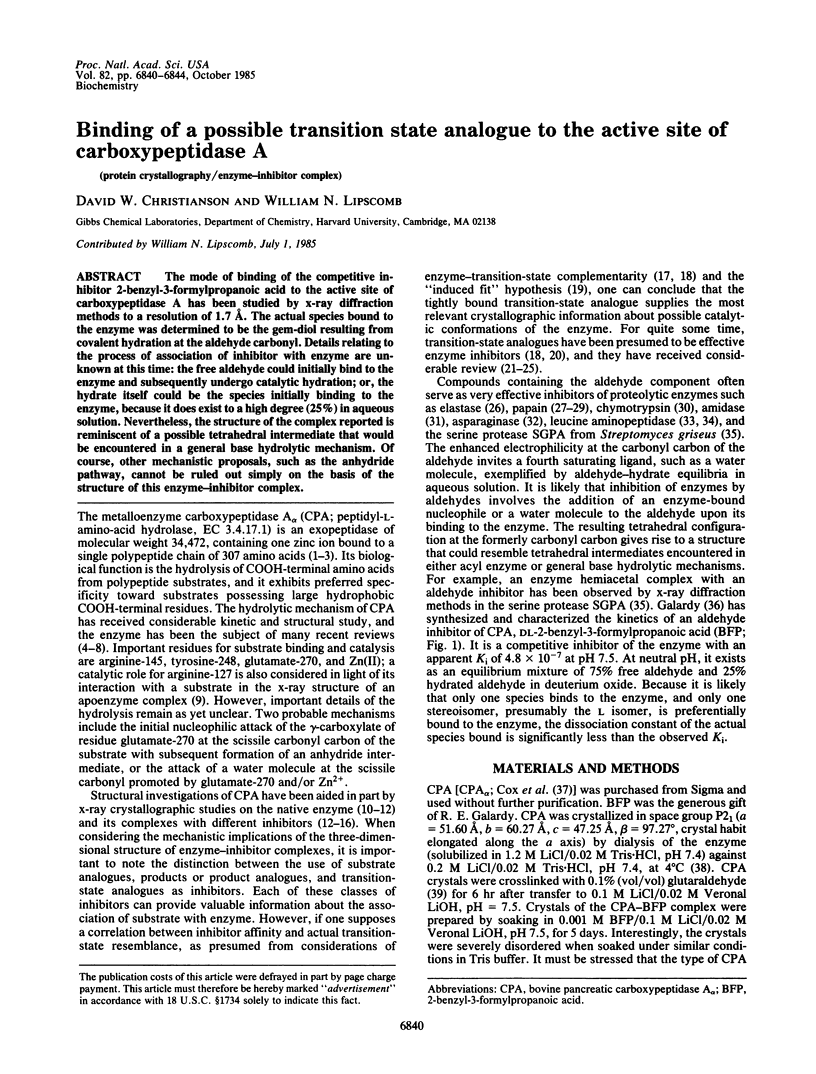
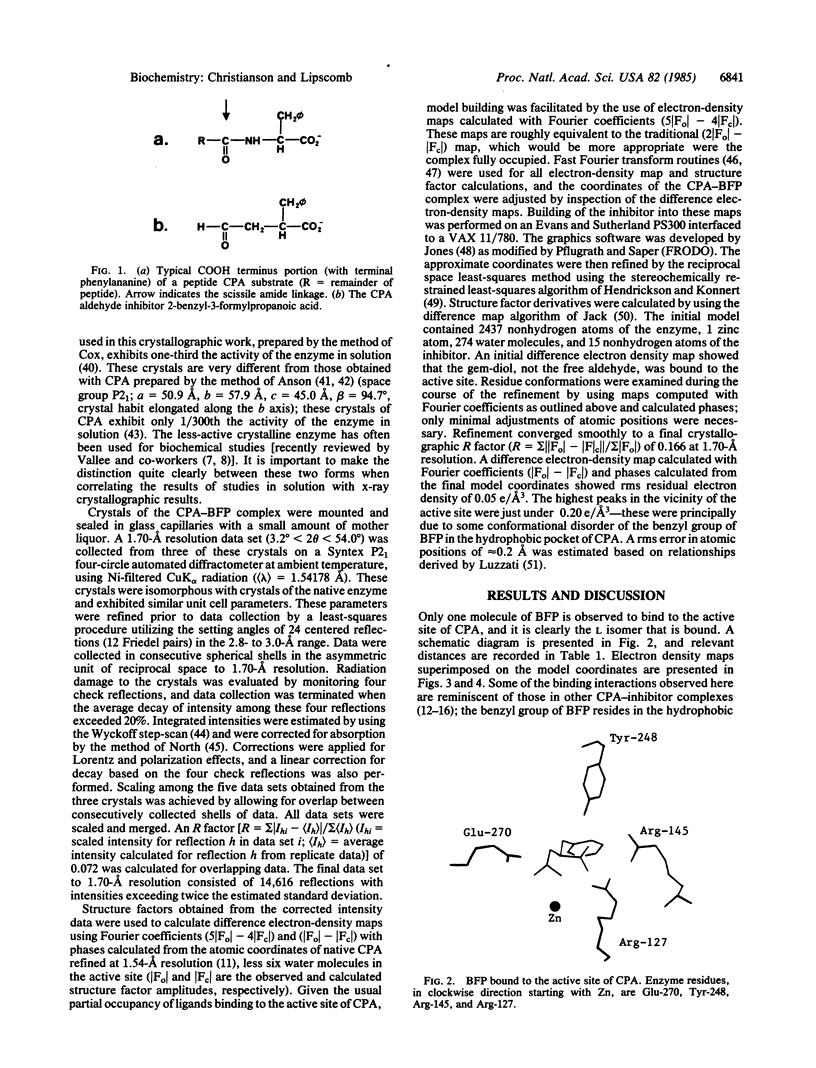
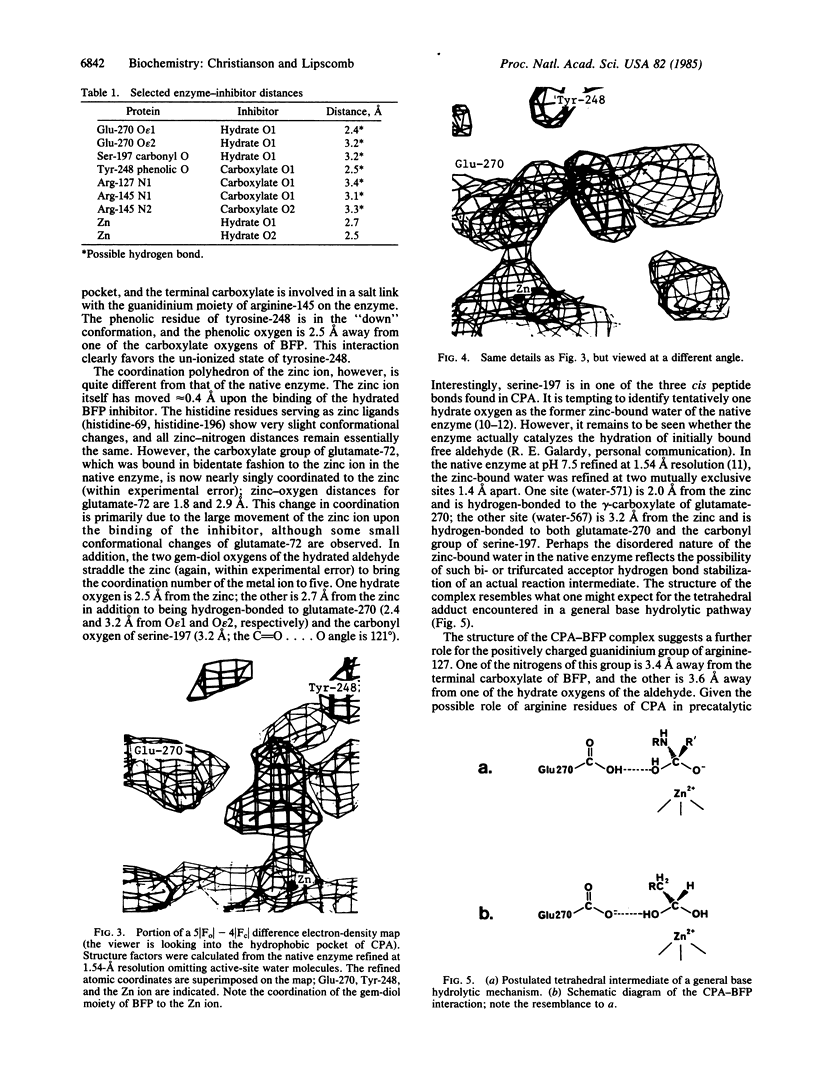
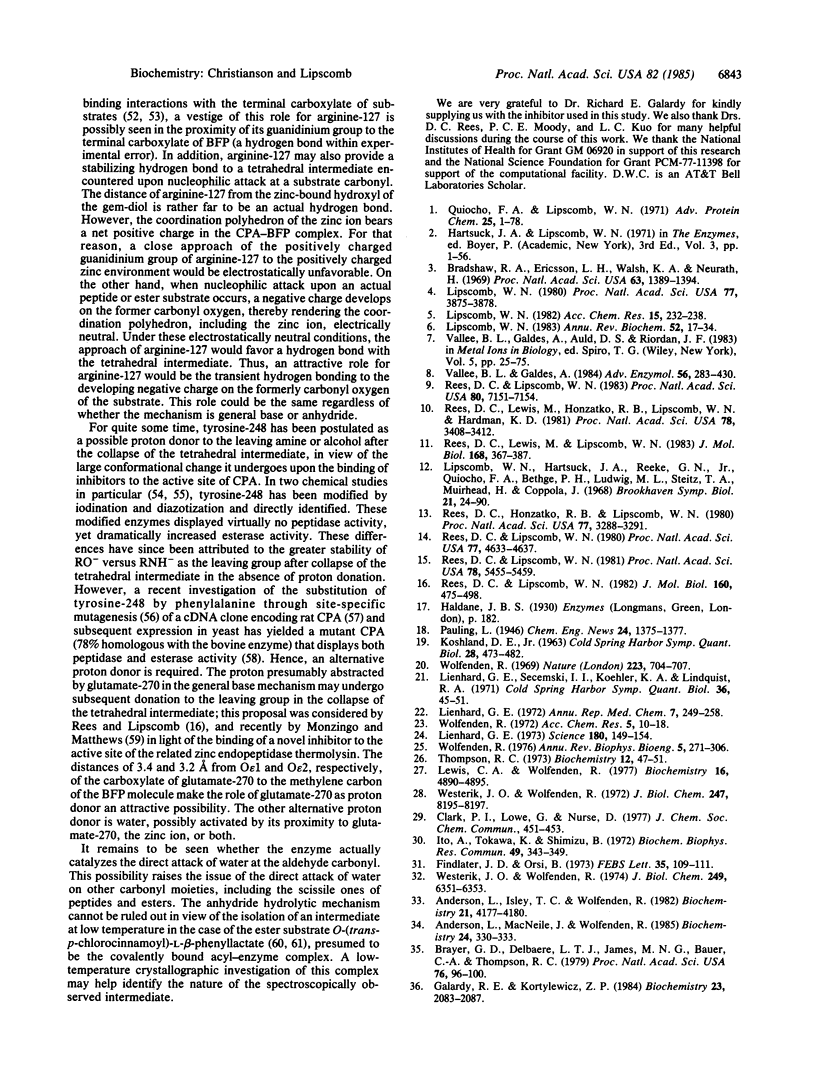
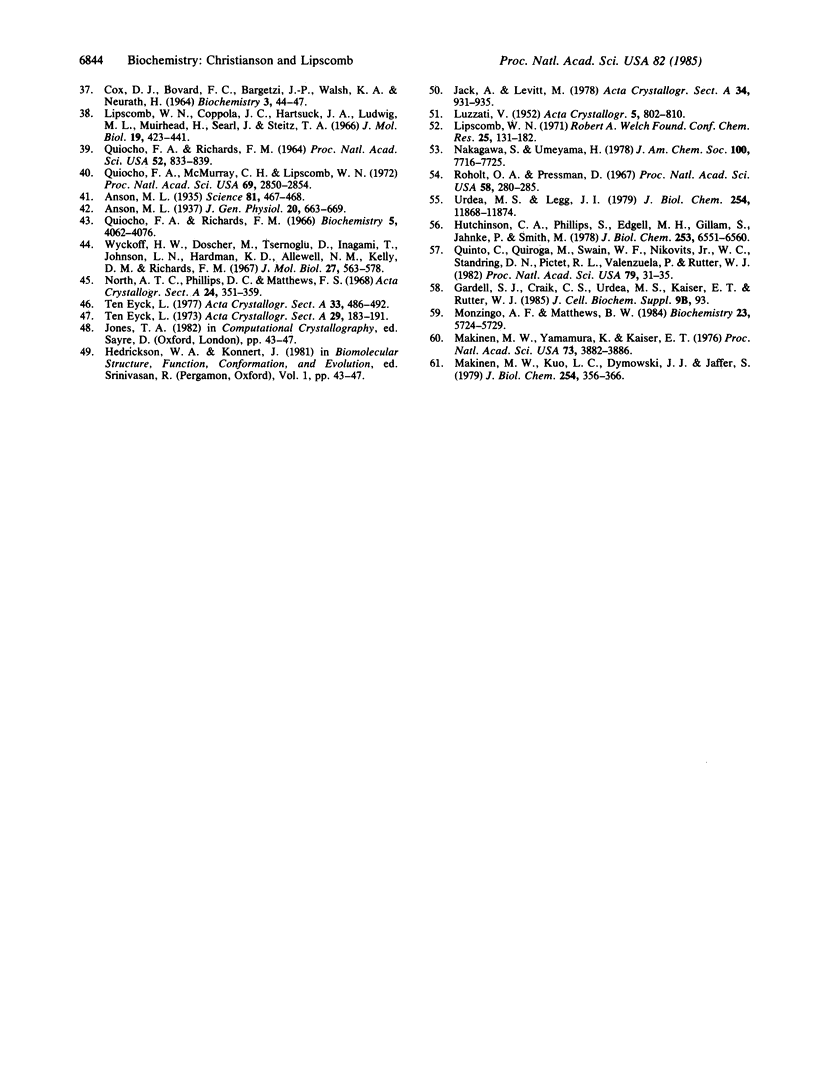
Selected References
These references are in PubMed. This may not be the complete list of references from this article.
- Andersson L., Isley T. C., Wolfenden R. alpha-aminoaldehydes: transition state analogue inhibitors of leucine aminopeptidase. Biochemistry. 1982 Aug 17;21(17):4177–4180. doi: 10.1021/bi00260a040. [DOI] [PubMed] [Google Scholar]
- Andersson L., MacNeela J., Wolfenden R. Use of secondary isotope effects and varying pH to investigate the mode of binding of inhibitory amino aldehydes by leucine aminopeptidase. Biochemistry. 1985 Jan 15;24(2):330–333. doi: 10.1021/bi00323a014. [DOI] [PubMed] [Google Scholar]
- Anson M. L. CRYSTALLINE CARBOXYPOLYPEPTIDASE. Science. 1935 May 10;81(2106):467–468. doi: 10.1126/science.81.2106.467. [DOI] [PubMed] [Google Scholar]
- Bradshaw R. A., Ericsson L. H., Walsh K. A., Neurath H. The amino acid sequence of bovine carboxypeptidase A. Proc Natl Acad Sci U S A. 1969 Aug;63(4):1389–1394. doi: 10.1073/pnas.63.4.1389. [DOI] [PMC free article] [PubMed] [Google Scholar]
- Brayer G. D., Delbaere L. T., James M. N., Bauer C. A., Thompson R. C. Crystallographic and kinetic investigations of the covalent complex formed by a specific tetrapeptide aldehyde and the serine protease from Streptomyces griseus. Proc Natl Acad Sci U S A. 1979 Jan;76(1):96–100. doi: 10.1073/pnas.76.1.96. [DOI] [PMC free article] [PubMed] [Google Scholar]
- COX D. J., BOVARD F. C., BARGETZI J. P., WALSH K. A., NEURATH H. PROCEDURES FOR THE ISOLATION OF CRYSTALLINE BOVINE PANCREATIC CARBOXYPEPTIDASE A. II. ISOLATION OF CARBOXYPEPTIDASE A-ALPHA FROM PROCARBOXYPEPTIDASE A. Biochemistry. 1964 Jan;3:44–47. doi: 10.1021/bi00889a008. [DOI] [PubMed] [Google Scholar]
- Findlater J. D., Orsi B. A. Transition-state analogs of an aliphatic amidase. FEBS Lett. 1973 Sep 1;35(1):109–111. doi: 10.1016/0014-5793(73)80588-5. [DOI] [PubMed] [Google Scholar]
- Galardy R. E., Kortylewicz Z. P. Inhibition of carboxypeptidase A by aldehyde and ketone substrate analogues. Biochemistry. 1984 Apr 24;23(9):2083–2087. doi: 10.1021/bi00304a032. [DOI] [PubMed] [Google Scholar]
- Hutchison C. A., 3rd, Phillips S., Edgell M. H., Gillam S., Jahnke P., Smith M. Mutagenesis at a specific position in a DNA sequence. J Biol Chem. 1978 Sep 25;253(18):6551–6560. [PubMed] [Google Scholar]
- Ito A., Tokawa K., Shimizu B. Peptide aldehydes inhibiting chymotrypsin. Biochem Biophys Res Commun. 1972 Oct 17;49(2):343–349. doi: 10.1016/0006-291x(72)90416-0. [DOI] [PubMed] [Google Scholar]
- Lewis C. A., Jr, Wolfenden R. Thiohemiacetal formation by inhibitory aldehydes at the active site of papain. Biochemistry. 1977 Nov 1;16(22):4890–4895. doi: 10.1021/bi00641a023. [DOI] [PubMed] [Google Scholar]
- Lienhard G. E. Enzymatic catalysis and transition-state theory. Science. 1973 Apr 15;180(4082):149–154. doi: 10.1126/science.180.4082.149. [DOI] [PubMed] [Google Scholar]
- Lienhard G. E., Secemski I. I., Koehler K. A., Lindquist R. N. Enzymatic catalysis and the transition state theory of reaction rates: transition state analogs. Cold Spring Harb Symp Quant Biol. 1972;36:45–51. doi: 10.1101/sqb.1972.036.01.009. [DOI] [PubMed] [Google Scholar]
- Lipscomb W. N. Carboxypeptidase A mechanisms. Proc Natl Acad Sci U S A. 1980 Jul;77(7):3875–3878. doi: 10.1073/pnas.77.7.3875. [DOI] [PMC free article] [PubMed] [Google Scholar]
- Lipscomb W. N., Hartsuck J. A., Reeke G. N., Jr, Quiocho F. A., Bethge P. H., Ludwig M. L., Steitz T. A., Muirhead H., Coppola J. C. The structure of carboxypeptidase A. VII. The 2.0-angstrom resolution studies of the enzyme and of its complex with glycyltyrosine, and mechanistic deductions. Brookhaven Symp Biol. 1968 Jun;21(1):24–90. [PubMed] [Google Scholar]
- Lipscomb W. N. Structure and catalysis of enzymes. Annu Rev Biochem. 1983;52:17–34. doi: 10.1146/annurev.bi.52.070183.000313. [DOI] [PubMed] [Google Scholar]
- Makinen M. W., Kuo L. C., Dymowski J. J., Jaffer S. Catalytic role of the metal ion of carboxypeptidase A in ester hydrolysis. J Biol Chem. 1979 Jan 25;254(2):356–366. [PubMed] [Google Scholar]
- Makinen M. W., Yammura K., Kaiser E. T. Mechanism of action of carboxypeptidase A in ester hydrolysis. Proc Natl Acad Sci U S A. 1976 Nov;73(11):3882–3886. doi: 10.1073/pnas.73.11.3882. [DOI] [PMC free article] [PubMed] [Google Scholar]
- Monzingo A. F., Matthews B. W. Binding of N-carboxymethyl dipeptide inhibitors to thermolysin determined by X-ray crystallography: a novel class of transition-state analogues for zinc peptidases. Biochemistry. 1984 Nov 20;23(24):5724–5729. doi: 10.1021/bi00319a010. [DOI] [PubMed] [Google Scholar]
- QUIOCHO F. A., RICHARDS F. M. INTERMOLECULAR CROSS LINKING OF A PROTEIN IN THE CRYSTALLINE STATE: CARBOXYPEPTIDASE-A. Proc Natl Acad Sci U S A. 1964 Sep;52:833–839. doi: 10.1073/pnas.52.3.833. [DOI] [PMC free article] [PubMed] [Google Scholar]
- Quinto C., Quiroga M., Swain W. F., Nikovits W. C., Jr, Standring D. N., Pictet R. L., Valenzuela P., Rutter W. J. Rat preprocarboxypeptidase A: cDNA sequence and preliminary characterization of the gene. Proc Natl Acad Sci U S A. 1982 Jan;79(1):31–35. doi: 10.1073/pnas.79.1.31. [DOI] [PMC free article] [PubMed] [Google Scholar]
- Quiocho F. A., Lipscomb W. N. Carboxypeptidase A: a protein and an enzyme. Adv Protein Chem. 1971;25:1–78. doi: 10.1016/s0065-3233(08)60278-8. [DOI] [PubMed] [Google Scholar]
- Quiocho F. A., McMurray C. H., Lipscomb W. N. Similarities between the conformation of arsanilazotyrosine 248 of carboxypeptidase A in the crystalline state and in solution. Proc Natl Acad Sci U S A. 1972 Oct;69(10):2850–2854. doi: 10.1073/pnas.69.10.2850. [DOI] [PMC free article] [PubMed] [Google Scholar]
- Rees D. C., Honzatko R. B., Lipscomb W. N. Structure of an actively exchanging complex between carboxypeptidase A and a substrate analogue. Proc Natl Acad Sci U S A. 1980 Jun;77(6):3288–3291. doi: 10.1073/pnas.77.6.3288. [DOI] [PMC free article] [PubMed] [Google Scholar]
- Rees D. C., Lewis M., Honzatko R. B., Lipscomb W. N., Hardman K. D. Zinc environment and cis peptide bonds in carboxypeptidase A at 1.75-A resolution. Proc Natl Acad Sci U S A. 1981 Jun;78(6):3408–3412. doi: 10.1073/pnas.78.6.3408. [DOI] [PMC free article] [PubMed] [Google Scholar]
- Rees D. C., Lewis M., Lipscomb W. N. Refined crystal structure of carboxypeptidase A at 1.54 A resolution. J Mol Biol. 1983 Aug 5;168(2):367–387. doi: 10.1016/s0022-2836(83)80024-2. [DOI] [PubMed] [Google Scholar]
- Rees D. C., Lipscomb W. N. Binding of ligands to the active site of carboxypeptidase A. Proc Natl Acad Sci U S A. 1981 Sep;78(9):5455–5459. doi: 10.1073/pnas.78.9.5455. [DOI] [PMC free article] [PubMed] [Google Scholar]
- Rees D. C., Lipscomb W. N. Crystallographic studies on apocarboxypeptidase A and the complex with glycyl-L-tyrosine. Proc Natl Acad Sci U S A. 1983 Dec;80(23):7151–7154. doi: 10.1073/pnas.80.23.7151. [DOI] [PMC free article] [PubMed] [Google Scholar]
- Rees D. C., Lipscomb W. N. Refined crystal structure of the potato inhibitor complex of carboxypeptidase A at 2.5 A resolution. J Mol Biol. 1982 Sep 25;160(3):475–498. doi: 10.1016/0022-2836(82)90309-6. [DOI] [PubMed] [Google Scholar]
- Rees D. C., Lipscomb W. N. Structure of the potato inhibitor complex of carboxypeptidase A at 2.5-A resolution. Proc Natl Acad Sci U S A. 1980 Aug;77(8):4633–4637. doi: 10.1073/pnas.77.8.4633. [DOI] [PMC free article] [PubMed] [Google Scholar]
- Roholt O. A., Pressman D. The sequence around the active-center tyrosyl residue of bovine pancreatic carboxypeptidase A. Proc Natl Acad Sci U S A. 1967 Jul;58(1):280–285. doi: 10.1073/pnas.58.1.280. [DOI] [PMC free article] [PubMed] [Google Scholar]
- Thompson R. C. Use of peptide aldehydes to generate transition-state analogs of elastase. Biochemistry. 1973 Jan 2;12(1):47–51. doi: 10.1021/bi00725a009. [DOI] [PubMed] [Google Scholar]
- Urdea M. S., Legg J. I. A peptidase-inactive derivative of carboxypeptidase A modified specifically at tyrosine 248. Cobalt(III) (ethylenediamine-N,N'-diacetato) (arsanilazotyrosinato 248 carboxypeptidase A). J Biol Chem. 1979 Dec 10;254(23):11868–11874. [PubMed] [Google Scholar]
- Vallee B. L., Galdes A. The metallobiochemistry of zinc enzymes. Adv Enzymol Relat Areas Mol Biol. 1984;56:283–430. doi: 10.1002/9780470123027.ch5. [DOI] [PubMed] [Google Scholar]
- Westerik J. O., Wolfenden R. Aldehydes as inhibitors of papain. J Biol Chem. 1972 Dec 25;247(24):8195–8197. [PubMed] [Google Scholar]
- Westerik J. O., Wolfenden R. Aspartic-beta-semialdehyde: a potent inhibitor of Escherichia coli L-asparaginase. J Biol Chem. 1974 Oct 10;249(19):6351–6353. [PubMed] [Google Scholar]
- Wolfenden R. Transition state analog inhibitors and enzyme catalysis. Annu Rev Biophys Bioeng. 1976;5:271–306. doi: 10.1146/annurev.bb.05.060176.001415. [DOI] [PubMed] [Google Scholar]
- Wolfenden R. Transition state analogues for enzyme catalysis. Nature. 1969 Aug 16;223(5207):704–705. doi: 10.1038/223704a0. [DOI] [PubMed] [Google Scholar]
- Wyckoff H. W., Doscher M., Tsernoglou D., Inagami T., Johnson L. N., Hardman K. D., Allewell N. M., Kelly D. M., Richards F. M. Design of a diffractometer and flow cell system for X-ray analysis of crystalline proteins with applications to the crystal chemistry of ribonuclease-S. J Mol Biol. 1967 Aug 14;27(3):563–578. doi: 10.1016/0022-2836(67)90059-9. [DOI] [PubMed] [Google Scholar]


